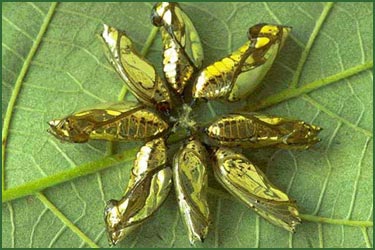The Butterfly Effect
By Keane J Shore

Can butterfly 'farming' help save the world's vanishing rainforests?
There's a hypothesis in chaos theory that tiny air currents rippling out from a single butterfly's wings can swell into a storm half a world away. If one wing beat could alter the atmosphere, what about clouds of the colourful insects?
Wild theories aside, butterflies can change the climate by helping to save the world's remaining tropical forests. These vast tracts of trees are often called the 'lungs of the planet.' Their foliage draws in the carbon dioxide that causes global warming and converts it to oxygen. Rainforests are home to approximately half of the world's plant, animal and insect species, including countless types of butterflies.
Tropical forests are also a habitat for butterfly farmers. Under net enclosures hung behind small wooden huts in rainforests ringing the earth's equator, rural residents are 'harvesting' crops of butterflies instead of chopping down trees to make a living.
And every acre counts, because more than one tree has already fallen in the global forest. Many tropical stands are under intense pressure from commercial logging, cattle ranching and families clearing land just to survive. Each year, rainforests equalling the size of England are lost forever.
In the Brazilian Amazon, the world's largest rainforest, deforestation continues at an alarming rate. The Smithsonian Tropical Research Institute warns that the Amazon could vanish by the year 2020. Rare tropical plants have been sources for new medicines, but as unknown species are cleared away, so too are potentially life-saving drugs.

Logging concessions already cover half of the world's second largest tropical rainforest, located in Central Africa. Costa Rica, with its reputation as a leader in protecting rainforests, allows extensive logging in unprotected areas - four-fifths of its wood stands have been felled in the last century.
In contrast to cutting, a butterfly farm is a small island of rainforest preserved for the captive breeding and growing of a few of the world's 20,000 butterfly species. The farmers sell mounted dead specimens and dried or 'papered' butterflies to collectors and artists. They also supply butterfly pupae (cocoons ready to hatch) to live exhibits in Europe and North America.
The first live butterfly conservatory opened in Britain in the late 1970s. There are now about 250 similar exhibits in the world, mainly in Europe with about a dozen in North America. Most of the insects for these public butterfly houses are flown in from the Third World.
Twenty years ago, Joris Brinckerhoff and his wife Maria Sabido started Costa Rica's first butterfly farm, simply called La Finca de Mariposa or The Butterfly Farm. As their business has grown, becoming a tourist attraction and employing dozens, others have started looking at butterflies in a new light. Brinckerhoff has helped 70-odd families set up their own small farms, and started a company that exports nine-tenths of Costa Rica's farmed butterflies.
Brinckerhoff says the low-tech farms, as small as a quarter hectare, can be started over a year or two for about U.S.$1,000. The main equipment needed is a shed to feed caterpillars and package cocoons, and a house-sized net cage that covers the forest floor. In and around the cage, a farmer uses local host plants to feed the kinds of butterflies he or she raises.
Farmers collect the pinhead-sized eggs from the leaves where they are laid. They grow the eggs into caterpillars, feeding them plant cuttings. When the caterpillars hide themselves in chrysalises, or cocoons, farmers collect, pack and ship them to market, keeping some to lay new eggs in captivity and some for wild release.

Butterfly farms can create employment in rural areas where opportunities and income are scarce. It's one of the few industries where people living in and around forests can earn as much as they would in less environmentally benign ways. It also diversifies Costa Rica's economy beyond staple exports such as coffee, bananas and sugar.
Many butterfly harvesters in Costa Rica are women from low-income families. With good markets, common sense and a strong work ethic, a farmer can prosper. Those that supply Brinckerhoff's export company can earn US$700 per month, double to triple what they can earn elsewhere. This good money entices farmers to preserve their existing forests, or to re-grow trees and indigenous plants on degraded land.
In Kenya, a study of butterfly farming in and around the Arabuko Sokoke Forest paints a similar picture. Butterfly farming can be done at home with a small investment in time, money and habitat. While it didn't directly reduce the illegal tree cutting common to the forest, butterfly farmers and other locals tended to view trees less as fodder for fires, and more as a valuable standing resource.
So why aren't all struggling African agriculturists and Central American campesinos trying to hatch similar schemes? There is a natural limit to this winged enterprise, says Brinckerhoff. He already has a long waiting list of would-be butterfly farmers, but contracting them would badly dilute other farmers' earnings. For that reason, he thinks butterfly farms alone cannot save rainforests.
"In theory, butterfly farming is the perfect industry for preserving tropical forests," says Brinckerhoff. It is, after all, a pesticide-free, environmentally benign enterprise that provides local jobs and brings badly needed foreign currency into developing countries.
"In practice, however, the market is so limited that only a few hundred farmers worldwide can really benefit." Without care, the global trade in butterflies can easily be flooded and financially cripple the industry. It happened once in the Philippines and has come close in Central America.
"Right now, we're at a good level of production versus demand," says entomologist Mike Weissmann, executive director of the International Association of Butterfly Exhibitions. "But well-intentioned environmental groups that are trying to start new farms might be doing more damage than good, as far as the economics of butterfly farming go."
Butterfly farming is never going to be the latest get-rich-quick-while-saving-the-rainforest scheme. Weissmann believes farmed butterflies can best help the environment in the role of public relations 'star' of the bug world. Live butterfly exhibits can motivate customers to contribute to conservation, helping both the insects and their homes. Some people will go the eco-tourism route, travelling to rainforests and opening their wallets to the local economy.
"Butterflies are great ambassadors," says Weissmann. "Even people who dislike insects will make an exception in the case of butterflies."
"No one is going to go to a cockroach zoo, but they'll come to a butterfly house. Once you get them in the door, you can introduce them to the rest of the [rainforest] world."
Once a visitor is caught in this net of interest, they can be told about the forest plants and animals that butterflies need to survive. The farms are home to orchids and other rare plants, ferns, fungi, monkeys, rodents and other small animals, lizards and reptiles, frogs and amphibians, parrots and numerous birds, and an unknowable number of less camera-friendly insects playing critical parts in their small ecosystems. Among the world's live butterfly exhibits is the seven-year-old Niagara Park Butterfly Conservatory in Niagara Falls, Ontario. The Cdn$15-million, 1,000-square-metre attraction is billed as one of North America's largest collections of free-flying butterflies. Cheryl Tyndall, assistant curator, says the conservatory flies at least 40 species and about 2,000 individual butterflies at any time. The park breeds half of its own live butterflies, but buys the rest from tropical farms.
"All of our butterflies are from farms either in the Philippines, Malaysia, Costa Rica or El Salvador," says Tyndall. "We don't accept anything that's wild-caught."
The butterfly trade, estimated at somewhere between US$5-million and $15-million per year, also deals in what's called 'dead stock.' Doug Curry, an entomologist at Toronto's Royal Ontario Museum, says the museum's souvenir shop sells mounted and framed butterflies, all farmed, for about Cdn$60 each. He sees farmed butterflies as resources that renew far quicker than trees, with side benefits for other creatures.
"There are a lot of other organisms that are less charismatic that get saved in the process," says Curry. "If the forest has to be maintained for [butterfly] propagation, then this is a good thing."
Whether butterfly farming in itself can save tropical stands is a question still up in the air. But it is one example of seeing the forest for the trees. There are others, such as Canada's successfully exported 'Model Forest' program. It's a participatory process that gets everyone in a wooded area onboard to create community jobs while sustainably managing their forests.
It's a Canadian concept being put into practice in many corners of the world, including Chiloé, an island lying off the southern coast of Chile. Home to 150,000 people in an area approximately 180 by 50 kilometres, the island was once entirely forested, but only 50 percent of the temperate rainforest remains.
Sixty Chiloé communities, covering nearly the entire island, are now learning how to plan and manage their forests for the long-term. Careful selection logging has taken root, and there is a new emphasis on eco-tourism and non-wood products such as honey and hazelnuts. Both the community's income and the area covered by trees have increased.
"Communities are now very strong. They've even resisted [logging] offers from multinational companies," says Sylvain Legault, a former CUSO cooperant who volunteered in Chiloé for two years.
These and other forests of the future offer practical ways of working with an ecosystem instead of merely exploiting it.
And that's an idea as powerful as the beat of a single butterfly's wing.
Written November 2003.
| Return to Top
|
| Articles Archive
| About Our Times |